REVIEW: Light at Tarragon Theatre
The following review is a conversation between Intermission Senior Editor Aisling Murphy and theatre critic Karen Fricker. Karen saw Light in-person at Tarragon on Tuesday, March 8 and the digital recording of the production at home in Toronto on Wednesday, March 16. Aisling also viewed the digital recording at home in Toronto on Wednesday, March 16.
The following is a transcription of Karen and Aisling’s conversation, which took place over Zoom on the morning of Saturday, March 19, 2022. It has been edited for length and clarity.
Aisling Murphy (AM): So… how do we want to start this?
Karen Fricker (KF): Well… we can start by introducing the terms of our engagement with the show. The original plan was that I’d only see it live, and you’d only see it digitally, but in fact I watched the digital version too because I was intrigued by the play and I wanted to engage with it again. There were things I wanted to see close-up, and I was able to appreciate the difference between the play being received by an audience and not — the filmed version wasn’t filmed before an audience.
AM: Well, right, and that comes through pretty clearly. I’m curious about your in-person experience. How did the audience react to it? Was it a full house? How was the in-person-ness of it all?
KF: Still no full house — Tarragon was still limiting audiences to about half capacity, and, yes, the audience absolutely responded. There are some funny lines, funny situations, interactive moments, wall-breaking moments.
I have to say that for me, being inside that theatre felt so welcome, and so luxurious. It was a beautifully designed production. To walk in and see Michael Gianfrancesco’s set — and there was sound design by Deanna H. Choi creating a world, even when we were just sitting down. Bonnie Beecher’s lighting too helped create an inviting atmosphere. The physical and sonic lushness of it really added to the experience.
AM: So that’s actually one of my curiosities, that sonic lushness — the drone, the musical drone that plays at the beginning. How was it in-person? It’s mastered really well for the digital production, and everything sounds really crisp.
KF: That sound was very compelling live, and they did a really good job figuring out how to transpose it digitally.
AM: Agreed. And to that end, I didn’t really know what to expect heading into the digital recording: I wasn’t thinking about how many cameras might be involved, or how the sound might be mastered. But the quality was really gorgeous. A lot of resources went into making a digital recording that didn’t feel like all the online theatre we’ve seen over the course of COVID. It felt quite a bit more intentional, and even more dramaturgically resonant. Choices around framing and how the camera panned to follow characters made a lot of sense.
KF: Totally. And one thing that was really striking to me about the production — I don’t know, since I haven’t seen the script, if this is something [writer] Rosa Labordé prescribed, or if [director] Jackie Maxwell discovered it in the creation process — but the other actors are frequently visible at the sides of the stage. There are things you can see in the digital production that I didn’t notice in person. An early shot has you looking at Willow (Sara Farb’s character) and behind her is Beni, Shakura Dixon’s character, reading Howl. You already have a cue about that character.
The actors being present on stage even while not active in a scene has a lot to do with the context of the ashram, I think. They’re in a group setting, and that staging choice felt like a meta-reference to that, creating a sense of intimacy bordering on claustrophobia. Often too it worked as efficient direction — an actor would sit to the side of the stage who was going to appear next in a scene. There is a chime sound, too, to advance each scene. I found that really smart.
AM: The pacing, yeah. I think we’re looking at a new work where if it’s not directed really precisely, it could start to drag or feel stilted — I mean, the language isn’t necessarily heightened, but it’s removed from everyday speech. The direction navigates that in a way such that the language feels organic and natural even when it isn’t. That’s so cool.
Also… okay. This might be a misreading. But I couldn’t stop thinking about it while I was watching the play. Light almost feels like a commentary on theatre school. A little. As much as it feels like an ashram, it also feels like a first-year acting class at NTS or wherever. The expected reverence for the teachers, and the maquettes! When they came in, those little scale models — that’s straight out of theatre school, how you build and visualize your set.
For me, being inside that theatre felt so welcome, and so luxurious.
KF: That’s interesting. I didn’t go there, but that strikes me as a valid reading. Amongst the things Labordé’s talking about is guru figures. And, I mean, there’s a yoga class! There’s a lot in there about embodiment, and the relationship between mind and body. Of course those are things that come up in acting as well.
Let’s switch gears a little; we can tag-team what we thought the play was actually about. I’ll start.
The play is set in an ashram, and we’re following the character Willow, played by Sara Farb, who’s just arrived, along with another person she doesn’t know and whose story we discover along the way. That character is Valentina, played by Maria Del Mar.
We’re cued from the beginning that Willow’s reason for being there is not just to have the experience and pursue the teachings, because the character of Mukti, the leader of the ashram’s wife, says to Willow, ‘I can’t believe you came.’ And so part of the intrigue of the play is figuring out these relationships — who is Willow to this place? Who is Willow to these people?
Over to you.
AM: I’ll complicate that reading with Willow’s spoken reason for being at the ashram, which is that she’s just had a bad breakup. I think that, too, cues us that we’ll not only be following her, but her relationships, and her relationship with being in relationships. I feel like the reading we get as an audience is ‘ashram according to Willow,’ as opposed to ‘ashram according to the truth.’
KF: Right. And the play takes a turn when Willow decides to write about her experience — she’s a writer. There’s an incredible scene where she’s talking into her phone; it’s an incredible piece of writing from Labordé. Essentially, Willow speaks the beginning of her written piece and it comes out of her whole. I found myself wondering, was she always planning on writing about this? Because she’s there to pursue her relationship with Mukti and this place — and she’s also there, yes, because she’s had a breakup. But then she roasts the place in a piece of New Yorker-style writing.
This play is a wonderful vehicle for female actors. Christine Horne is stunning as Angie, a character who could have dipped into stereotype or cliché. Undereducated, pregnant, single mom — and she makes these quirky miniatures or as you’re calling them, maquettes. She is such a wonderful actor. She was beautiful in this role.
Christine Horne is stunning as Angie, a character who could have dipped into stereotype or cliché.
AM: Totally. She brings such impressive layers of sadness to it that don’t really make her feel like a sob story or a martyr. It’s a cool character, and Horne’s done a lot with it.
KF: I really enjoyed Linda Kash as Mukti, too — she’s super-interesting in the part and gets to play in a number of different emotional registers, particularly towards the end of the play. Shakura Dickson is just luminous, all the time, and her character is this brilliant prodigy who doesn’t want to be profiled by Willow as a victim of her circumstances. She lit up the stage every time she entered. I also have so much time for Sara Farb as an actor, although I do have questions about Willow’s character.
AM: Yeah… to that end, though, I’m curious if we’re actually looking at these characters as they are, or at these characters as Willow perceives them. I almost wonder if moments of under-development or flatness can be attributed to the fact that that’s how Willow views them. So the fact that Angie is so complicated, and is so nuanced in performance, I think is kind of incredible, and a tribute to Horne’s performance. The way she’s written doesn’t dole out those details — it doesn’t seem to be how Willow would write her later on after the fact.
KF: That’s such a great reading. That can help us understand something about the character of Jesse, played by Philip Riccio. He’s in the ashram, he’s a gardener, he’s a yoga teacher, and he’s set up as a potential love interest for Willow. But at a certain point he pretty much disappears as a central figure, and perhaps your reading of the play explains why – he ceases to be of use to Willow, and she’s mortified [by his rejection].
We should acknowledge that Philip Riccio, who plays Jesse, is the publisher of Intermission, and is someone we both know.
AM: He signs my paychecks, yeah. Go on.
KF: I’ve seen him play very different characters, in, for example, 1979 and Jerusalem. He’s been excellent in everything I’ve seen. This is a different kind of character again to those, in which he is also convincing. There’s this quality of openness — you get why Willow is attracted to him. And then you find out he’s a critic. So of course that made me laugh internally.
AM: Karen. I screamed.
KF: I totally bought it. This was someone with a lot of layers, with a troubledness, or darkness he’s moving through or beyond. I also buy your reading that he stops being useful halfway through the play because he stops being useful to Willow, but to the extent to which we get to know his character, he’s well cast, and well played.
It’s a weird, brilliant, intimate play.
AM: Absolutely. And that happens with another character, too. After Beni (Dickson)’s first scene, I didn’t really see the point of the character yet — she seemed a little flat, a little under-developed — but as the play progressed, and as that character started to matter more to Willow, she also started to matter more to us. It’s a really cool interaction between the text and the execution of it, and I thought it worked really well.
KF: One of the reasons I wanted to see Light again digitally was that I wanted to get closer to Willow. There’s so much going on with that character that is unstated, or implied, or internalized, and I wanted to appreciate that performance from close-up. Not that I didn’t appreciate it from far away, but I got more about the character when I was able to see Sara Farb’s facial expressions.
AM: Sara Farb acts with her eyes so much! I found you could really get a lot from where her gaze was, or what she was doing with her eyes, rolling them or whatever.
KF: Also, Valentina and Willow bond through non-verbal communication – by not engaging with the ashram, making fun of it through eyerolls. There’s a relationship being built between them though non-verbal cues, which was much clearer in the digital version.
AM: Right, and that relationship is also much stronger when it’s entirely non-verbal. They even acknowledge it themselves: they realize their friendship falls apart the more they actually talk. I think what the play accomplishes through non-verbal elements is really surprising and impressive.
KF: When Valentina says something like, ‘I thought you were Latinx, I was speaking to you in Spanish in my mind!’ — that got a great laugh, a lot of warmth from the audience. You don’t get that in the digital version. I wish you could have experienced the warmth of that.
AM: Me too! I missed those audience reactions so much, and found myself wondering why they didn’t record the digital version in front of an audience. I missed that audience reaction. It’s such a weird, brilliant little play, but it’s definitely on the weird side — without that feedback, it was almost like I didn’t know where to look. Like, ‘can I laugh at that?’
I definitely missed audience reaction while watching the digital version.
KF: Let’s talk about that ‘lights-on’ moment in Light. I was thinking of Richard Rose’s production of Enemy of the People, which was based on the Ostermeier version — there’s a ‘lights-on’ moment where the audience gets implicated in the show, and this is apparently a trope in some Tarragon productions, that break in the action. I personally can’t make sense of why we needed that moment in this play — why Theo needed to acknowledge that this is a play, and that we’re in a theatre. How did you respond to it?
AM: Similarly jarred. It took me back to [Hannah Moscovitch’s] Sexual Misconduct of the Middle Classes, where, surprise surprise, the protagonist has written the play we just saw. It’s a similar thing, and I think that’s definitely a Tarragon trope. They like to involve us when they can, I guess. I mean… Rosa Labordé has really fastidiously built this little world, and so to take us out of it like that didn’t really feel earned. The team spent a lot of dramaturgical effort trying to make this world one we could live in for a few hours, so then to yank us out of it suddenly didn’t quite feel earned or supported.
On another note… can we talk about the playwriting for a second? Is that allowed?
KF: Sure.
AM: Okay. So. There’s this element that’s in there, and it almost feels a little like Chekhov’s gun. So when that ‘gun’ didn’t go off, I felt really unsettled.
There’s so many allusions to things catching fire, or being on fire in the ashram. There’s at least three: they talk about kitchen fires, and then cigarette fires, and then at the end, someone literally talks about ‘burning everything down.’ To me, that’s got me primed for a literal explosion, or some sort of physical manifestation of crisis and destruction. There are enough fire references that it feels like it must be intentional, but I can’t figure out why, if it’s never acted upon.
KF: To me, I mean… doesn’t Willow ‘burn it down’ with her article, despite being redeemed? Angie forgives her, and makes her a maquette, Willow acquires a family, and Beni’s going to live near her, and you get the impression that there might be a sisterly relationship, and a motherly relationship with Mukti.
My struggle, though — did Willow earn that? I mean, she burned that shit down, metaphorically speaking! And they forgave her!
AM: Okay, but… does Angie giving Willow the maquette mean she forgave her, though? I don’t know. To me it feels like that’s the cruellest thing Angie can do in that moment. She’s saying, ‘look at what you’ve done to us, here’s a constant reminder, it’s been made with care and as a gift, but it’s this constant reminder of what you’ve been through and what you’ve destroyed.’ So to me, it felt much more complicated than forgiveness.
KF: Oh! I remember something I wanted to say earlier. The question of why Theo breaks the fourth wall could be… there might be something there in your reading of this world as a metaphor for theatre. Angie’s maquette is of the set. It’s the ashram, but it’s clearly a theatre maquette of Gianfrancesco’s set.
AM: Well, right. So through what lens are we viewing the ashram? Is it as it is or how it’s perceived to be? You’re absolutely right — it’s not a maquette of the ashram, it’s a maquette of the set of the ashram, which is really cool.
KF: Well, I embrace your complexifying of Angie’s gift. Now that I think about it, they have this warm conversation at the end, and then… she goes. And she goes off to be Angie the single mom, not phased by Willow’s significant concerns about the parentage of the child.
AM: Right. And she’s presented to be… normal. She looks like a single mom. She’s not in yoga gear or anything like that. Outside of the ashram, she’s just a person. I don’t think she would have looked out of place in the cafe with Willow.
KF: Yeah. We don’t feel she’s just blown off the mountain or anything. She’s not wafting incense and wearing the uniform.
AM: The uniform! I think that leads me to my last point. I find it interesting that the ashram uniforms are just as much prison uniforms as they are anything else.
KF: The orange jumpsuits, yeah. The fact that everyone else is in that neutral khaki and then Mukti and Theo are in orange — it’s a signifier of prison, for sure [costumes are also by Gianfrancesco].
We’ve talked about many of the performances, and I’d like to mention that this was an excellent ensemble overall. A number of these actors are known for work in TV and film, and they weren’t as familiar to me as others in the cast. Hardee T. Lineham, Maurice Dean Wint, and Maria Del Mar I didn’t know as stage performers. It was really interesting to see them give fine performances not just from far away, but close up.
This is an excellent ensemble overall.
AM: And on that note, I think that’s about it.
KF: Cool. So this was fun, to tease out our responses to the play and production this way. This play lent itself to a conversational approach – it’s layered.
AM: I had fun, too — looking forward to the next conversation.
Light runs digitally at Tarragon through March 27. Tickets are available here.

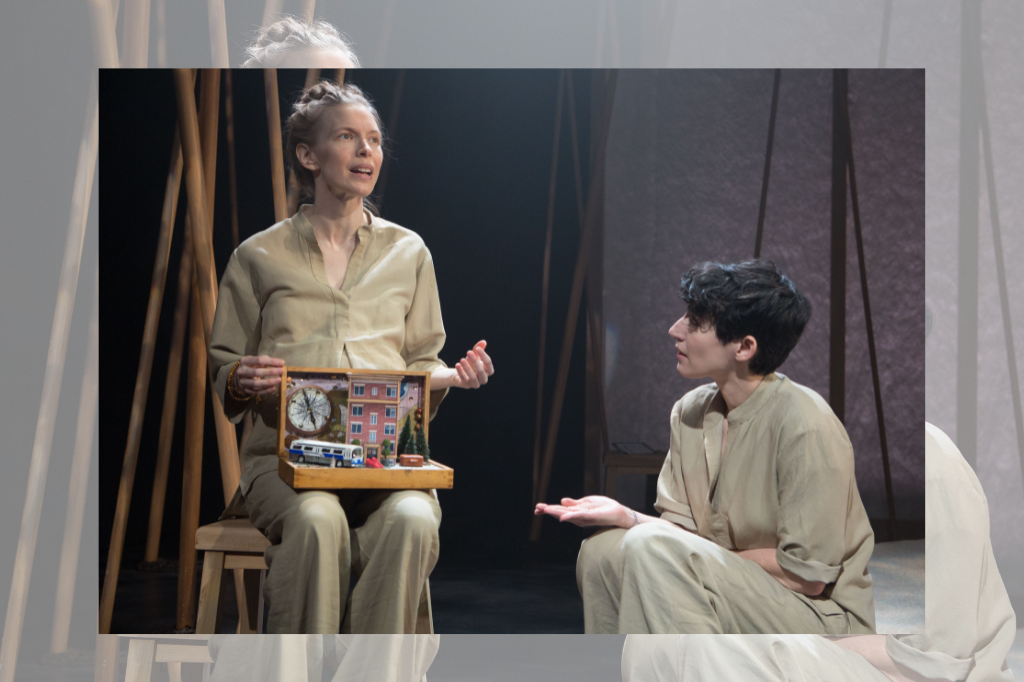
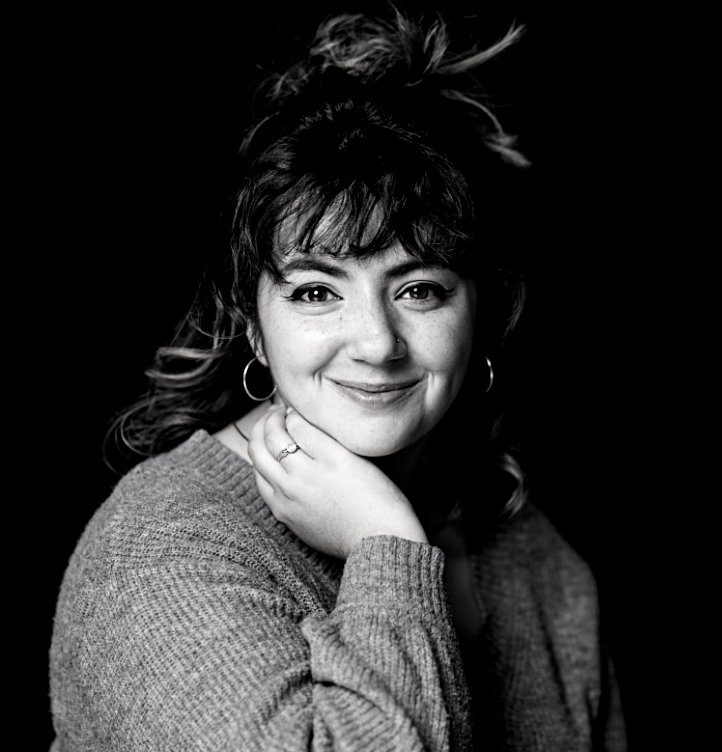
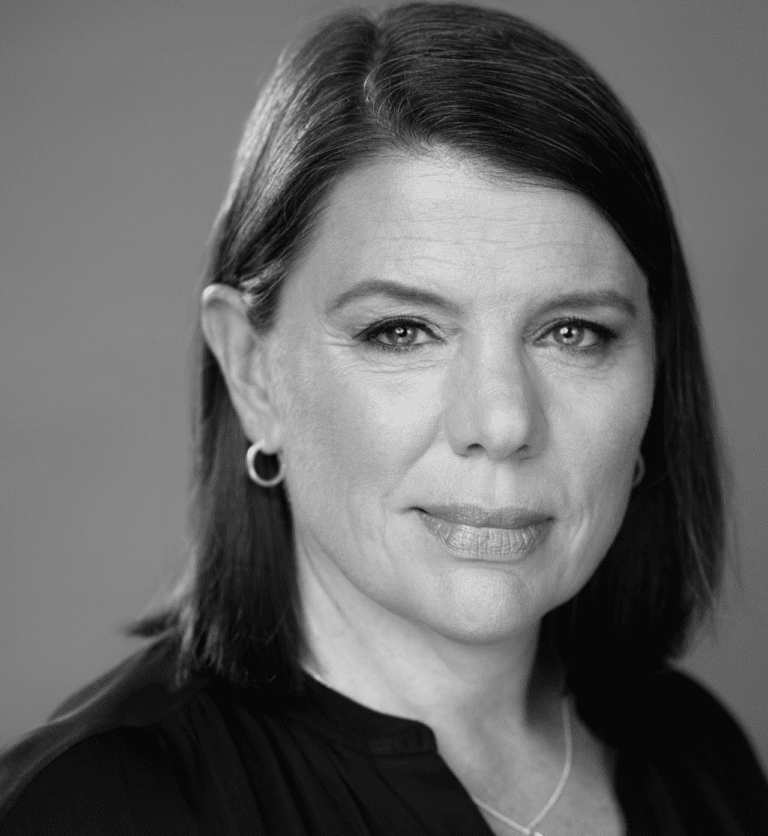







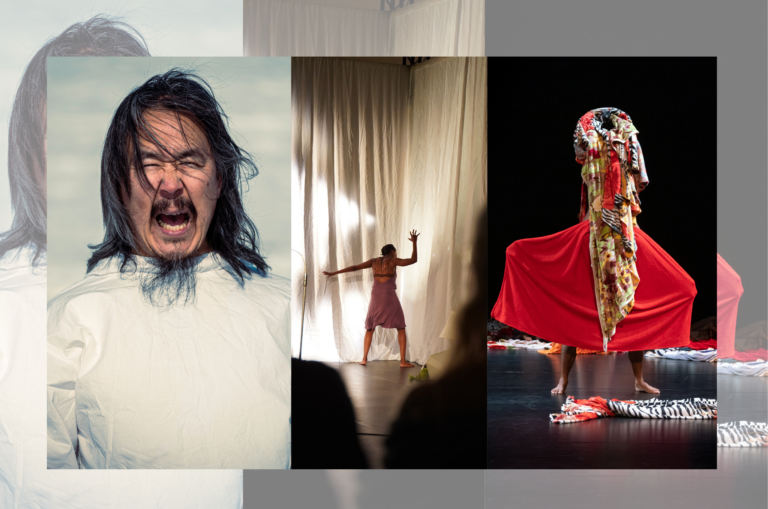
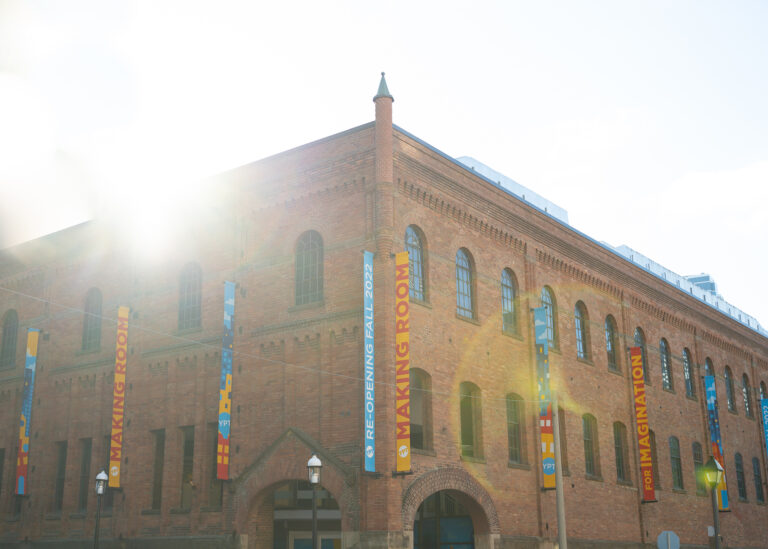
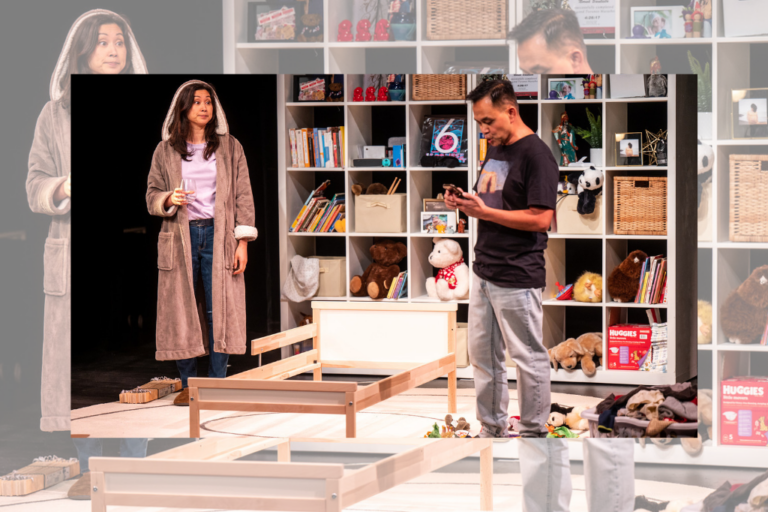
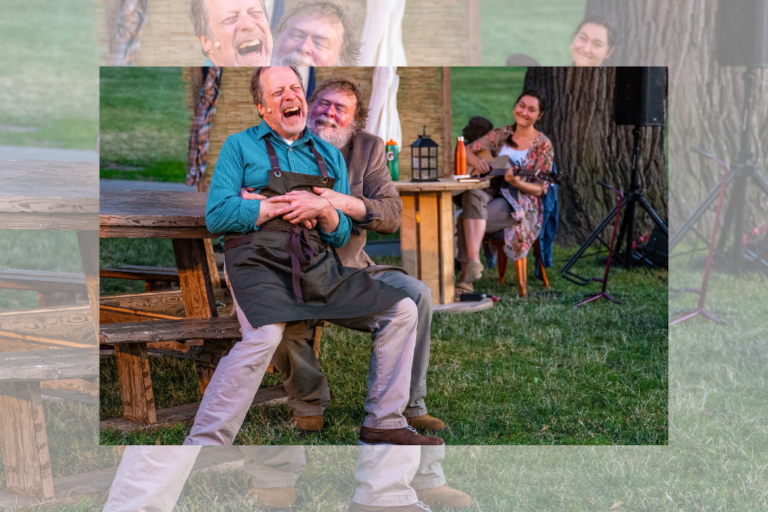
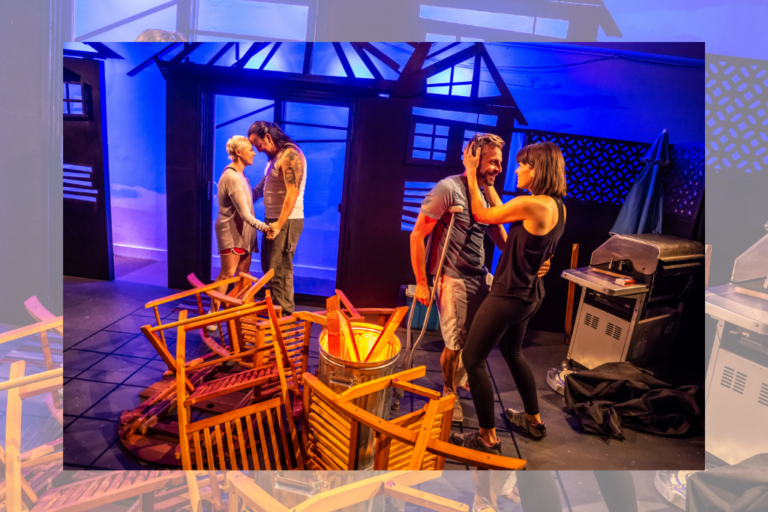
Comments